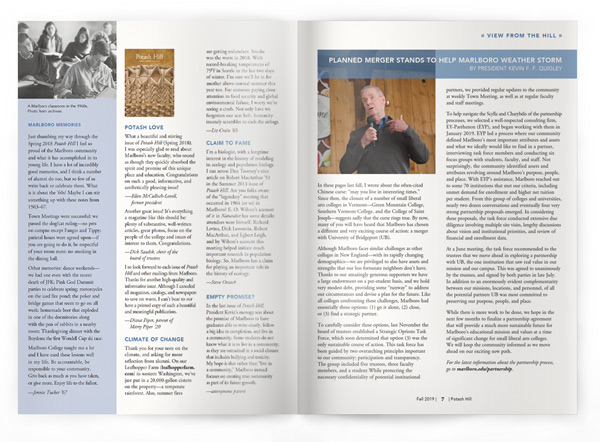View from the Hill

Planned Merger Stands to Help Marlboro Weather Storm
By President Kevin F. F. Quigley
In these pages last fall, I wrote about the often-cited Chinese curse: “may you live in interesting times.” Since then, the closure of a number of small liberal arts colleges in Vermont—Green Mountain College, Southern Vermont College, and the College of Saint Joseph—suggests sadly that the curse rings true. By now, many of you will have heard that Marlboro has chosen a different and very exciting course of action: a merger with University of Bridgeport (UB).
Although Marlboro faces similar challenges as other colleges in New England—with its rapidly changing demographics—we are privileged to also have assets and strengths that our less fortunate neighbors don’t have. Thanks to our amazingly generous supporters we have a large endowment on a per-student basis, and we hold very modest debt, providing some “runway” to address our circumstances and devise a plan for the future. Like all colleges confronting these challenges, Marlboro had essentially three options: (1) go it alone, (2) close, or (3) find a strategic partner.
To carefully consider these options, last November the board of trustees established a Strategic Options Task Force, which soon determined that option (3) was the only sustainable course of action. This task force has been guided by two overarching principles important to our community: participation and transparency. The group included five trustees, three faculty members, and a student. While protecting the necessary confidentiality of potential institutional partners, we provided regular updates to the community at weekly Town Meeting, as well as at regular faculty and staff meetings.
To help navigate the Scylla and Charybdis of the partnership processes, we selected a well-respected consulting firm, EY-Parthenon (EYP), and began working with them in January 2019. EYP led a process where our community defined Marlboro’s most important attributes and assets and what we ideally would like to find in a partner, interviewing task force members and conducting six focus groups with students, faculty, and staff. Not surprisingly, the community identified assets and attributes revolving around Marlboro’s purpose, people, and place.
With EYP’s assistance, Marlboro reached out to some 70 institutions that met our criteria, including unmet demand for enrollment and higher net tuition per student. From this group of colleges and universities, nearly two dozen conversations and eventually four very strong partnership proposals emerged. In considering these proposals, the task force conducted extensive due diligence involving multiple site visits, lengthy discussions about vision and institutional priorities, and review of financial and enrollment data.
At a June meeting, the task force recommended to the trustees that we move ahead in exploring a partnership with UB, the one institution that saw real value in our mission and our campus. This was agreed to unanimously by the trustees, and signed by both parties in late July. In addition to an enormously evident complementarity between our missions, locations, and personnel, of all the potential partners UB was most committed to preserving our purpose, people, and place.
While there is more work to be done, we hope in the next few months to finalize a partnership agreement that will provide a much more sustainable future for Marlboro’s educational mission and values at a time of significant change for small liberal arts colleges. We will keep the community informed as we move ahead on our exciting new path.
While this issue of Potash Hill was in the mail, on August 13, negotiations for this merger were called off. For the latest information about the partnership process, go to our website.
